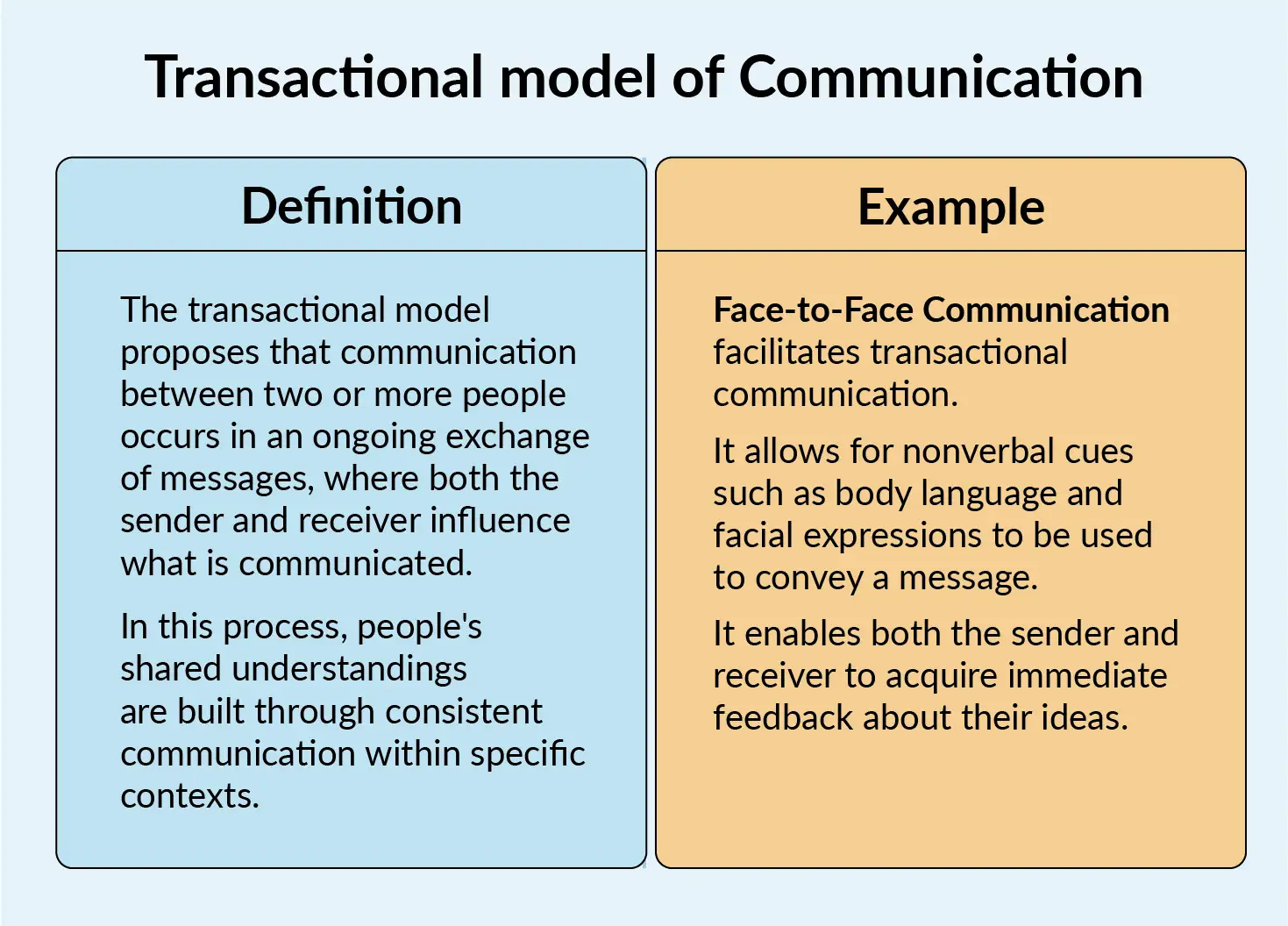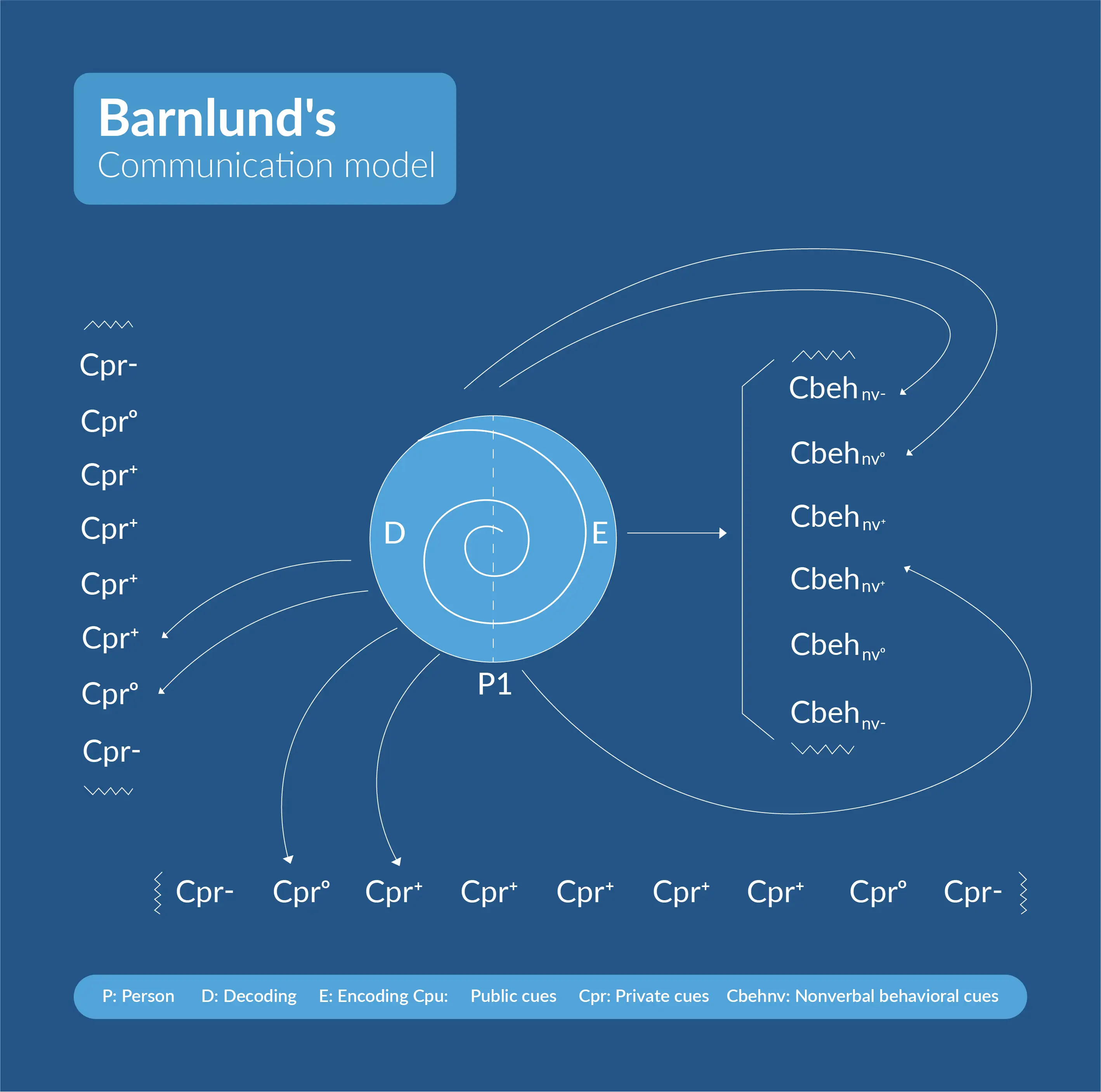Transactional model of communication: Definition, examples & more

Communication is the foundation of human interaction, shaping how we exchange ideas, collaborate, and build relationships. Over the years, several communication models have been developed to explain how messages are transmitted and understood. Among these, the transactional model of communication stands out due to its focus on the complex, continuous, and reciprocal nature of communication. Unlike older models that treat communication as a one-way process, the transactional model views communication as an ongoing, interactive process where all parties are engaged simultaneously.
This article looks into the transactional model of communication, offering insights into its definition, real-life examples, different types, and practical applications. Additionally, we will examine how this model differs from others, its advantages and limitations, and best practices for applying the transactional model in everyday communication.
What is the transactional model of communication?
The transactional model of communication views communication as a dynamic, ongoing process in which people are both senders and receivers of messages at the same time. Rather than seeing communication as a linear transfer of information, this model emphasizes that communication is simultaneous and involves constant adjustments based on feedback from all participants. In this sense, communication is never static; it’s shaped by various elements, such as non-verbal cues, the cultural context, and the nature of the relationship between the communicators.
Unlike the linear model of communication, which simply describes communication as a process where one party sends a message and the other receives it, the transactional model recognizes that communication involves multiple layers of feedback, context, and non-verbal communication. Each person involved in the communication process plays an active role, constantly encoding and decoding messages in real-time.

Core elements of the transactional model:
- Communicators: In the transactional model, both participants are referred to as "communicators" instead of "sender" or "receiver." Both parties engage simultaneously in sending and receiving messages.
- Message: The content of communication, which includes both spoken words and non-verbal signals like gestures, facial expressions, and tone of voice.
- Channel: The medium through which the communication occurs, such as face-to-face communication, phone calls, email, or social media.
- Feedback: Real-time responses from communicators that allow them to adjust their messages in response to reactions. Feedback is a key feature in the transactional model, helping participants refine their communication for better understanding.
- Noise: External or internal factors that can disrupt the communication process. For instance, background noise, emotional distractions, or preconceived notions can interfere with how a message is received and interpreted.
- Context: The environment in which communication occurs, including social, cultural, and relational contexts. This context greatly influences how messages are interpreted, as it encompasses the shared values, norms, and expectations within the communication setting.
Example: Consider a job interview. While the interviewer asks questions, the interviewee is not just passively listening—they’re nodding, maintaining eye contact, or offering verbal feedback ("That's an interesting question"). The interviewer then adjusts their follow-up questions based on the interviewee's reactions. This real-time exchange, where both parties are continuously shaping the conversation, embodies the transactional model of communication.
How the transactional model differs from other communication models
To understand the significance of the transactional model, it’s helpful to compare it with other communication models, particularly the linear model and the interactive model.

Linear model
The linear model of communication is one of the earliest communication theories. It portrays communication as a one-way process in which a sender transmits a message to a receiver without any feedback. This model is effective for understanding mass communication, such as television broadcasts or public announcements, where there is little or no opportunity for the audience to respond directly. However, the linear model fails to account for the role of feedback, context, or the complex, two-way process that occurs in everyday communication.
Interactive model
The interactive model of communication builds upon the linear model by introducing feedback as a key component. It treats communication as a series of exchanges, where one person sends a message, and the other responds. While this model improves upon the linear approach, it still sees communication as a turn-based process rather than a simultaneous one. This model is often used to describe email communication or other forms of communication where there is a time gap between sending and receiving messages.
Transactional model
The transactional model takes a more holistic approach, recognizing communication as simultaneous and dynamic. Both participants are engaged in sending and receiving messages at the same time, making the process more fluid and continuous. The model also accounts for the influence of context, including cultural context, relational context, and social context, which are critical in shaping how messages are interpreted.
Examples of transactional communication
Transactional communication can be observed in nearly every aspect of daily life. Below are examples that showcase how this model works in various contexts:
Face-to-Face conversations
In face-to-face communication, both participants send and receive messages continuously. Verbal communication is supplemented by non-verbal communication such as body language, facial expressions, and tone of voice. For instance, when two friends meet for coffee and chat, they are constantly adjusting their messages based on each other's reactions—whether it’s a smile, a nod, or a puzzled look. This interaction model emphasizes the continuous, two-way nature of communication.
Video conference calls
In the age of remote work, video conferencing has become a primary means of communication. During a Zoom call, for example, one team member may present an idea while others provide non-verbal feedback (nodding, frowning) or verbal input ("Can you clarify that?"). The presenter adapts based on this feedback, creating a fluid, real-time exchange of ideas. Transactional communication is particularly effective in digital formats where participants are often located in different physical spaces.
Text messaging
Although text messaging lacks the richness of non-verbal cues, it still follows the principles of the transactional model of communication. When you send a message, the recipient responds, and the conversation evolves based on their response. For instance, if you send a message asking, “Are you free tomorrow?” and the recipient replies with “Yes,” you might then propose a plan. The conversation continuously builds on the feedback from both participants.
Emails and letters
Though emails and letters may seem more static, they still involve transactional elements. An email exchange between colleagues may include formal responses, but feedback (even delayed) shapes the conversation. For example, after receiving feedback on a project update via email, a team member can adjust their approach based on the responses, continuing the transactional exchange.
Business presentations
In the corporate world, presentations are a prime example of how transactional communication occurs. Even though one person is often speaking while others listen, the speaker is continuously receiving feedback from the audience through non-verbal cues like nods, confused expressions, or engagement through questions. For instance, during a quarterly review presentation, if the audience seems disengaged or confused, the speaker can adjust their approach, slow down, or ask for clarifications, maintaining an interactive flow that keeps the communication alive.
Social media interactions
Social media platforms like Instagram and Twitter are modern forms of transactional communication. For instance, when a company posts a promotional message, users respond by liking, commenting, or sharing the post. The company can then respond to individual comments, continuing the conversation in real-time. The context in which communication takes place—social media in this case—shapes how messages are framed and understood.
Types of transactional modes of communication
Various versions of the transactional model have been developed over the years, offering deeper insights into how communication works in different settings.
Barnlund’s transactional model
Dean Barnlund introduced a sophisticated take on the transactional model by emphasizing the multi-layered nature of communication. He noted that communication isn’t just a simple exchange of words—it includes a simultaneous transmission of verbal and non-verbal cues, emotions, and environmental context. In his model, Barnlund highlighted that communication is more like a negotiation between parties, each sending and receiving messages on various levels.

For example, imagine two business partners negotiating a contract. While one partner verbally discusses contract terms, they also send non-verbal signals like leaning forward to show interest or crossing arms to indicate discomfort. Both partners are interpreting these cues while simultaneously adjusting their own verbal and non-verbal behaviors. Barnlund’s model excels in emphasizing how non-verbal communication is as important, if not more, than spoken words.
Real-life application: This model is often used in counseling, therapy, and diplomacy, where non-verbal cues like body language, facial expressions, and even silence are critical in understanding the full spectrum of communication.
Dance’s Helical model of communication
Frank Dance proposed the Helical Model of Communication, which adds a temporal dimension to the transactional framework. He visualized communication as a helix—a continuously spiraling shape that grows wider as it expands. This concept suggests that communication is cumulative and evolutionary. Each conversation builds upon previous interactions, growing more complex and rich over time.
For instance, think of two friends who meet after years apart. Their first conversation may be simple, filled with pleasantries and catching up. However, as they spend more time together, their communication deepens, shaped by shared memories and experiences. Dance’s model is particularly useful for understanding how long-term relationships evolve in terms of communication.

Real-life application: Dance's model is relevant in long-term professional relationships, marriages, and mentor-mentee dynamics, where each conversation is influenced by past interactions and knowledge.
Advantages and disadvantages of transactional models communication
The transactional model offers several benefits, but it also has its challenges.
Advantages:
- Realistic representation: This model mirrors how communication actually works in real life, emphasizing the continuous flow of messages and feedback.
- Feedback-centric: Immediate feedback helps correct misunderstandings quickly and enhances message clarity.
- Non-verbal inclusion: By incorporating non-verbal elements (body language, facial expressions), the transactional model offers a more holistic view of communication.
- Cultural sensitivity: It accounts for context, including cultural, emotional, and social factors, making it adaptable to various communication scenarios.
- Simultaneous exchange: The model captures the simultaneous, dynamic nature of communication, unlike other models that view it as a linear process.
Disadvantages:
- Overly complex: With multiple layers (feedback, context, noise, non-verbal cues), the model can be too intricate to apply in all situations, especially for quick or simple exchanges.
- Risk of misinterpretation: With so many factors in play, there’s a higher chance of misinterpreting feedback, especially if noise (internal or external) distorts the message.
- Dependent on active participation: For the model to work effectively, both parties must be fully engaged. If one party is passive or distracted, communication breaks down.
Best practices for transaction model
To get the most out of the transactional model of communication, consider the following best practices:
- Actively listen: Engagement is key to transactional communication. Actively listen to what the other person is saying, paying attention to both verbal and non-verbal cues.
- Consider context: Always be mindful of the cultural, social, and relational context in which communication occurs. Tailor your message based on the audience and environment.
- Provide feedback: Whether through words, gestures, or facial expressions, feedback helps ensure that communication flows smoothly. Clear, constructive feedback is essential for effective communication.
- Be aware of non-verbal signals: Non-verbal communication can often speak louder than words. Pay attention to the tone of voice, body language, and facial expressions, as these can influence how your message is received.
Frequently asked questions (FAQs)
1. What does the transactional communication model highlight about communication as a two-way process?
The transactional communication model highlights that communication is a two-way process where both participants are actively involved in sending and receiving messages. Unlike linear models, this model of communication describes communication as a simultaneous interaction, with constant feedback from both communicators, making it dynamic and adaptable.
2. How does the role of context influence communication in the transactional model?
The role of context is essential in the transactional model of communication because it shapes how messages are understood and how participants interact. Cultural context, social context, and the specific relational context all influence the meaning of communication. These contexts act as frameworks that help participants interpret both verbal and non-verbal cues, allowing for more accurate understanding in various situations.
3. How can the transactional model of communication improve communication in the real world?
In communication in the real world, the transactional model helps people adapt their communication styles based on ongoing feedback from their conversation partner. This model encourages more effective communication by considering the entire interaction as a dynamic process involving continuous adjustments, enabling communicators to better understand and respond to each other's needs and messages.
4. What are some common criticisms of the transactional model of communication?
One of the major criticisms of the transactional model is its complexity. The model assumes that communicators are fully engaged and constantly providing feedback, which may not always happen in every scenario. It also requires careful consideration of communication barriers, such as noise, distractions, or misinterpretation, which can disrupt the process of communication and lead to misunderstanding.
5. How does the process in which communicators generate messages differ in the transactional model?
In the transactional model, the process in which communicators generate messages is seen as continuous and interactive. Both parties are communication partners who adjust their messages based on the feedback they receive. This real-time interaction differs from other models, where the receiver in the transaction model passively accepts information without influencing the ongoing exchange. Here, both communicators influence each other, creating a richer and more complex interaction.
6. What components of the communication process are emphasized in the transactional model?
The components of the communication process that are emphasized in the transactional model include feedback, context, and the simultaneous roles of sending and receiving. The transactional model of communication emphasizes that communication is not just the exchange of information but a circular process that continuously adapts based on the interaction between participants and their environment.
How Prezent supports transactional communication through presentations
Prezent enhances the transactional mode of communication by enabling users to create engaging, well-structured presentations that foster better interaction and audience engagement. The platform offers features that align with the principles of this model, ensuring that presentations are not just one-way deliveries of information but two-way processes that adapt based on feedback and context.
Tailored presentations for audience engagement
Prezent, with features like Communication Fingerprints, allows users to customize their presentations to meet the specific needs of their audience. By understanding the preferences and expectations of different groups, presenters can create contextually appropriate content that resonates with the audience, leading to more effective communication. This supports the context in the transactional model, helping communicators adjust their messages to the cultural, social, or relational backgrounds of their audience.
Enhancing clarity and reducing barriers
Prezent helps presenters minimize communication barriers by offering tools that simplify complex information. The platform’s AI-driven features generate clear, visually appealing slides that help reduce ambiguity and misunderstanding—key concerns in transactional communication. This allows presenters to focus on real-time interaction with their audience rather than worrying about technical aspects of the presentation.
Supporting non-verbal communication
In presentations, non-verbal elements are crucial for audience engagement. Prezent provides templates and design options that incorporate effective use of visuals, helping the presenter communicate more than just words. The use of images, diagrams, and animations allows the presenter to convey complex ideas in a way that is easily digestible for the audience, supporting the non-verbal communication aspect of the transactional model.
Presentations serve as a prime example of transactional communication by enabling real-time feedback and interaction, incorporating contextual relevance, and utilizing both verbal and non-verbal cues. Prezent enhances this mode of communication by offering tools that make presentations more engaging, clear, and adaptive to audience feedback, fully supporting the continuous, dynamic nature of the transactional model of communication. Try the features of Prezent with a free account, or join for a quick demo at your time.



.avif)








